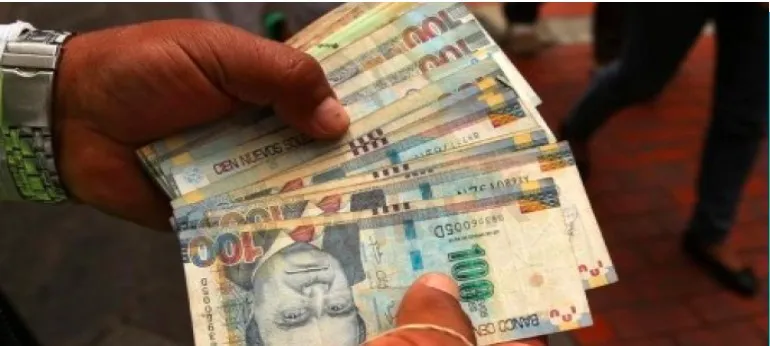简体中文
繁體中文
English
Pусский
日本語
ภาษาไทย
Tiếng Việt
Bahasa Indonesia
Español
हिन्दी
Filippiiniläinen
Français
Deutsch
Português
Türkçe
한국어
العربية
EMERGING MARKETS-Latam FX to snap 5-week winning streak, Peru sol lifted by rate hike
Abstract:Latin American currencies were set for their first weekly decline in six on Friday as the dollar strengthened on worries of aggressive Federal Reserve action, while Peru's sol was supported by a sharp interest rate hike.
The MSCI's index for Latin American currencies .MILA00000CUS was set for weekly falls of 0.4%, though it rose about 1% on the day.
Currencies in the resource-rich South and Central American regions have been gaining for the last five weeks due to tighter monetary policies, lack of direct exposure to the conflict in Ukraine and a sharp rise in commodity prices.

After starting 2022 near parity, developed markets became increasingly riskier than emerging markets... DMs have underperformed EMs, and DMs total risk
remains above that of EM, said Diana Baechle, principal of applied research at financial intelligence firm Qontigo.
But as the United States and other developed markets embark on monetary tightening cycles, investors fear that those rising rates could drain capital from higher-yielding and riskier emerging markets, weighing on
their currencies.
Fed minutes this week highlighted the need for more hikes through the year, and the dollar index against a basket of other hard currencies =USD rose to 100 for the first time in nearly two years. FRX/
The sol PEN= gained 0.2% after Peru's central bank raised its benchmark interest rate 50 basis points to 4.5% on Thursday.
It is the highest rate since 2009, as authorities battle stubborn inflation that has sparked angry protests and rattled center-left President Pedro Castillo's administration.
The country's economy is still being weighed down by protests hitting copper mines, a central bank official said Friday.
The Brazilian real BRL=, BRBY gained 1% against the dollar. Data showed inflation in March was the highest in 28 years as higher fuel prices weighed on the economy.
Chile's peso CLP= slipped 1.1%. Data showed consumer prices rocketed 1.9% in March, the highest monthly rise in almost thirty years.
Mexico had posted red-hot inflation figures in Thursday, with its peso MXN= up 0.5% on the day.
These reports suggested that even as markets rallied on the recent surge in commodity prices, it also drastically increased inflationary pressures in such economies.
“The larger-than-expected rises in inflation in both Chile and Brazil support our view that their central banks will raise interest rates by more than most currently expect over the coming months,” William Jackson, chief emerging markets economist at Capital Economics said.
As central banks in Latam pursue their rate-hiking cycles, fears linger around that policy's impact on real economic growth.
Disclaimer:
The views in this article only represent the author's personal views, and do not constitute investment advice on this platform. This platform does not guarantee the accuracy, completeness and timeliness of the information in the article, and will not be liable for any loss caused by the use of or reliance on the information in the article.
Read more

BSP Set to Follow Fed's Rate Cuts to Stabilize PH Peso vs USD
Philippines Central Bank (BSP) is set to follow the Fed's rate cuts to stabilize the PH Peso over USD, maintaining a favorable interest rate spread and supporting the economy.

Philippine Peso Hits 5-Month High in August on Low Inflation
The Philippine peso reached a 5-month high in August, closing at P56.111:$1, driven by lower inflation and regional currency trends.

US-China Deal Enhances Forex Stability and Trading
The recent US-China financial stability agreement enhances forex market stability and trading opportunities by improving transparency and cooperation.

Mesh and Fireblocks Partner to Enhance Digital Payments
Mesh partners with Fireblocks to boost digital asset security and efficiency, transforming business and consumer experiences with advanced digital payment solutions.
WikiFX Broker
Latest News
CySEC Warns Against Unauthorized Investment Firms in Cyprus
Why Even the Highly Educated Fall Victim to Investment Scams?
Warning Against Globalmarketsbull & Cryptclubmarket
Dukascopy Bank Expands Trading Account Base Currencies
UK Sets Stage for Stablecoin Regulation and Staking Exemption
Axi Bids AUD 52M to Acquire Low-Cost Broker SelfWealth, Outbidding Competitor Bell Financial
Crypto Influencer's Body Found Months After Kidnapping
STARTRADER Issues Alerts on Fake Sites and Unauthorized Apps
Italy’s CONSOB Blocks Seven Unregistered Financial Websites
Bitfinex Hacker Ilya Lichtenstein Sentenced to 5 Years in Prison
Currency Calculator


